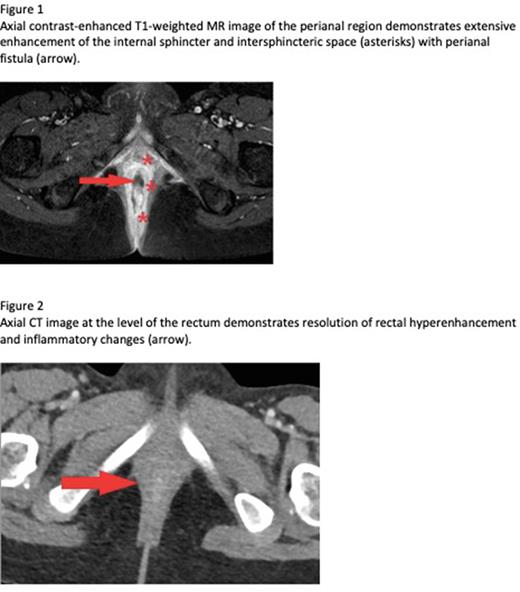Abstract
Background: Idiopathic aplastic anemia (IAA) is a rare, life-threatening acquired form of bone marrow failure characterized by multilineage cytopenias and hypocellular bone marrow. Profound neutropenia associated with very severe aplastic anemia (vsAA) is an important risk factor for development of life-threatening fungal and bacterial infections. Perirectal cellulitis and perianal abscess are one such infection and are associated with high rates of morbidity. The ability to eradicate infections in IAA is limited by the lack of imminent neutrophil recovery prior to treatment with either immune suppressive therapy (IST) or hematopoietic stem cell transplant (HSCT). We describe the successful use of granulocyte transfusion to treat antibiotic refractory proctitis with perianal abscess in a profoundly neutropenic child with vsAA.
Case: A 7yoF presented with fever and pancytopenia in the setting of Human Metapneumovirus and Parainfluenza. Bone marrow biopsy showed hypocellularity (60-70%) with granulocytic and megakaryocytic hypoplasia, favoring viral suppression. Ultimately, she progressed to transfusion dependence. Repeat bone marrow aspirate and biopsy ultimately revealed bone marrow aplasia, DEB chromosomes, telomere lengths, and PNH clones were negative, confirming the diagnosis of vsAA. She was subsequently admitted for febrile neutropenia (F&N) and was found to have mild respiratory COVID-19, but began to complain of rectal pain that was initially attributed to her history of constipation. She defervesced on IV antibiotics (abx) and was discharged home with negative cultures. Within a week she represented with hematochezia and F&N and was found to have proctitis with perianal fistula on MRI (figure 1); GI PCR panel was + Enteroaggregative E. coli, no resistant organisms were identified. She clinically improved and discharged on IV piperacillin-tazobactam (pip-tazo). Despite 2 weeks of IV abx, she developed new fever and imaging confirmed persistent proctitis with peri-rectal abscess. As she had limited response to abx alone we trialed a short course of granulocytes with improvement in anorectal inflammation by CT. She was discharged with a plan to continue IV pip-tazo until achieving radiographic cure; however, interval imaging after an additional 2 weeks of abx showed rebound of her proctitis and she was again admitted with F&N and rising inflammatory markers. Her failure to eradicate her peri-rectal infection despite prolonged antibiotics (>4weeks), along with her previous response to a short course of granulocyte transfusion prompted us to prescribe a prolonged 10-day course of granulocytes with continued antibiosis. Her post-granulocyte CT showed resolution of her perirectal abscess and proctitis (figure 2). With resolution of her infection, she was able to proceed to HSCT which she completed without recurrence of her anorectal infection.
Discussion: Conventional granulocyte transfusions are considered when patients have severe neutropenia (<500/uL), bacterial or fungal infection refractory to antimicrobials, and reasonable expectation of neutrophil recovery, but evidence for efficacy is limited. In our case, there was no expectation of imminent bone marrow recovery and our patient's infection limited her ability to proceed to IST or HSCT for treatment of her vsAA. Thus, in conjunction with infectious disease and transfusion medicine, and given her known response to granulocytes, we successfully re-attempted a prolonged, but limited, 10-day course of granulocyte transfusions and were able to eradicate a case of antibiotic-refractory proctitis with peri-anal fistula. We suggest an expanded application for the use of granulocytes in profoundly neutropenic patients without imminent recovery for severe, anti-microbial refractory infection.
Disclosures
No relevant conflicts of interest to declare.
Author notes
Asterisk with author names denotes non-ASH members.


